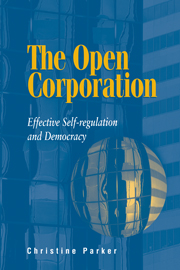Book contents
- Frontmatter
- Contents
- List of tables and figures
- Preface
- Acknowledgements
- 1 Introduction: Corporate self-regulation in the new regulatory State
- 2 The potential for self-regulation
- 3 Motivating top-management commitment to self-regulation
- 4 Cultivating self-regulation leadership
- 5 Self-regulation methodology and social harmony
- 6 The pathologies of self-regulation
- 7 Model corporate Citizens: The role of self-regulation Professionals
- 8 The three strategies of ‘permeability’ in the open Corporation
- 9 Meta-regulation: The regulation of self-regulation
- 10 Conclusion
- Appendix: Methodology
- Notes
- Reference
- Index
9 - Meta-regulation: The regulation of self-regulation
Published online by Cambridge University Press: 05 July 2014
- Frontmatter
- Contents
- List of tables and figures
- Preface
- Acknowledgements
- 1 Introduction: Corporate self-regulation in the new regulatory State
- 2 The potential for self-regulation
- 3 Motivating top-management commitment to self-regulation
- 4 Cultivating self-regulation leadership
- 5 Self-regulation methodology and social harmony
- 6 The pathologies of self-regulation
- 7 Model corporate Citizens: The role of self-regulation Professionals
- 8 The three strategies of ‘permeability’ in the open Corporation
- 9 Meta-regulation: The regulation of self-regulation
- 10 Conclusion
- Appendix: Methodology
- Notes
- Reference
- Index
Summary
Despite the dominance of organizations in contemporary social life, law is desperately short of techniques, doctrines and institutions that adequately respond to the social features of organizational entities, their impacts on stakeholders, their internal capacity for self-management, their capacity for diffusion and avoidance of accountability (see Dan-Cohen 1986: 13-14). Lack of corporate social and legal responsibility is not just a failure of corporate management. It is also a failure of legal regulatory institutions to interact with corporate organizations to make them open and permeable. Similarly, Community action often fails to permeate the corporate shell and engage with corporation's self-governance capacity. Corporate responsibility, or citizenship, is constituted in interaction between formal regulation (through the State), informal social action (the penumbra of democracy and institutions of civil society) and corporate self-regulation.
The role of corporate Citizens is to use permeable, responsible self-regulatory mechanisms (which meet all the requirements of Chapter 8) in order to determine for themselves how to instantiate regulatory responsibilities, and what values to follow within the grey areas where sufficient consensus has not yet been reached in the broader polity. The role of legal and regulatory strategies is to add the ‘triple loop’ that forces companies to evaluate and report on their own self-regulation strategies so that regulatory agencies can determine whether the ultimate Substantive objectives of regulation are being met (safe workplaces, equal opportunity, improved natural environments, sustainable development, market strength, and so on) (see Figure 9.3 for a diagrammatic representation of the triple loop).
- Type
- Chapter
- Information
- The Open CorporationEffective Self-regulation and Democracy, pp. 245 - 291Publisher: Cambridge University PressPrint publication year: 2002
- 2
- Cited by



